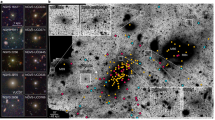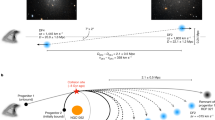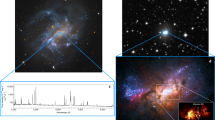Abstract
Dwarf galaxies have attracted increased attention in recent years, because of their susceptibility to galaxy transformation processes within rich galaxy clusters1,2,3. Direct evidence for these processes, however, has been difficult to obtain, with a small number of diffuse light trails4 and intra-cluster stars5,6 being the only signs of galaxy disruption. Furthermore, our current knowledge of dwarf galaxy populations may be very incomplete, because traditional galaxy surveys are insensitive to extremely diffuse or compact galaxies7. Aware of these concerns, we recently undertook an all-object survey of the Fornax galaxy cluster8. This revealed a new population of compact members9,10, overlooked in previous conventional surveys. Here we demonstrate that these ‘ultra-compact’ dwarf galaxies are structurally and dynamically distinct from both globular star clusters and known types of dwarf galaxy, and thus represent a new class of dwarf galaxy. Our data are consistent with the interpretation that these are the remnant nuclei of disrupted dwarf galaxies, making them an easily observed tracer of galaxy disruption.
This is a preview of subscription content, access via your institution
Access options
Subscribe to this journal
Receive 51 print issues and online access
$199.00 per year
only $3.90 per issue
Buy this article
- Purchase on Springer Link
- Instant access to full article PDF
Prices may be subject to local taxes which are calculated during checkout



Similar content being viewed by others
References
Moore, B., Katz, N., Lake, G., Dressler, A. & Oemler, A. Galaxy harassment and the evolution of clusters of galaxies. Nature 379, 613–616 (1996)
Bassino, L. P., Muzzio, J. C. & Rabolli, M. Are globular clusters the nuclei of cannibalized dwarf galaxies? Astrophys. J. 431, 634–639 (1994)
Bekki, K., Couch, W. J. & Drinkwater, M. J. Galaxy threshing and the formation of ultracompact dwarf galaxies. Astrophys. J. 552, L105–L108 (2001)
Gregg, M. D. & West, M. J. Galaxy disruption as the origin of intracluster light in the Coma cluster of galaxies. Nature 396, 549–552 (1998)
Durrell, P. R., Ciardullo, R., Feldmeier, J. J., Jacoby, G. H. & Sigurdsson, S. Intracluster red giant stars I the Virgo cluster. Astrophys. J. 570, 119–131 (2002)
Ford, H., Peng, E. & Freeman, K. In ASP Conf. Ser. 273: The Dynamics, Structure and History of Galaxies: A Workshop in Honour of Professor Ken Freeman 41 (Astronomical Society of the Pacific, San Francisco, 2002)
Disney, M. J. Visibility of galaxies. Nature 263, 573–575 (1976)
Drinkwater, M. J. et al. The Fornax spectroscopic survey. I. Survey strategy and preliminary results on the redshift distribution of a complete sample of stars and galaxies. Astron. Astrophys. 355, 900–914 (2000)
Drinkwater, M. J., Jones, J. B., Gregg, M. D. & Phillipps, S. Compact stellar systems in the Fornax cluster: Super-massive star clusters or extremely compact dwarf galaxies? Publ. Astron. Soc. Aust. 17, 227–233 (2000)
Phillipps, S., Drinkwater, M. J., Gregg, M. D. & Jones, J. B. Ultracompact dwarf galaxies in the Fornax cluster. Astrophys. J. 560, 201–206 (2001)
Drinkwater, M. J., Gregg, M. D. & Colless, M. Substructure and dynamics of the Fornax cluster. Astrophys. J. 548, L139–L142 (2001)
Mieske, S., Hilker, M. & Infante, L. Ultra compact objects in the Fornax cluster of galaxies: Globular clusters of dwarf galaxies? Astron. Astrophys. 383, 823–837 (2002)
Lotz, J. M. et al. Dynamical friction in DE globular cluster systems. Astrophys. J. 552, 572–581 (2001)
Geha, M., Guhathakurta, P. & van der Marel, R. P. Internal dynamics, structure, and formation of dwarf elliptical galaxies. I. A Keck/Hubble Space Telescope study of six Virgo cluster dwarf galaxies. Astron. J. 124, 3073–3087 (2002)
Drinkwater, M. & Hardy, E. Extreme blue compact dwarf galaxies in the Virgo cluster. Astron. J. 101, 94–101 (1991)
Djorgovski, S. G. et al. Dynamical correlations for globular clusters in M31. Astrophys. J. 474, L19–L22 (1997)
Meylan, G. et al. Mayall II = G1 in M31: Giant globular cluster or core of a dwarf elliptical galaxy? Astron. J. 122, 830–841 (2001)
Hernquist, L. Performance characteristics of tree codes. Astrophys. J. Suppl. 64, 715–734 (1987)
Gnedin, O. Y. et al. The unique history of the globular cluster ω Centauri. Astrophys. J. 568, L23–L26 (2002)
Faber, S. M. & Jackson, R. E. Velocity dispersions and mass-to-light ratios for elliptical galaxies. Astrophys. J. 204, 668–683 (1976)
Bekki, K., Couch, W. J. & Shioya, Y. Passive spiral formation from halo gas starvation: Gradual transformation into S0s. Astrophys. J. 577, 651–657 (2002)
Hilker, M., Infante, L. & Richtler, T. The central region of the Fornax cluster. III. Dwarf galaxies, globular clusters, and cD halo—are there interrelations? Astron. Astrophys. Suppl. 138, 55–70 (1999)
Miller, B. W., Lotz, J. M., Ferguson, H. C., Stiavelli, M. & Whitmore, B. C. The specific globular cluster frequencies of dwarf elliptical galaxies from the Hubble Space Telescope. Astrophys. J. 508, L133–L137 (1998)
Hilker, M., Mieske, S. & Infante, L. Faint dwarf spheroidals in the Fornax cluster: A flat luminosity function. Astron. Astrophys. 397, L9–L12 (2003)
Ferguson, H. C. Population studies in groups and clusters of galaxies. II—A catalog of galaxies in the central 3.5 deg of the Fornax cluster. Astron. J. 98, 367–418 (1989)
Larsen, S. S. Young massive star clusters in nearby galaxies. II. Software tools, data reductions and cluster sizes. Astron. Astrophys. Suppl. 139, 393–415 (1999)
Merritt, D., Meylan, G. & Mayor, M. The stellar dynamics of omega centauri. Astron. J. 114, 1074–1086 (1997)
Burstein, D., Bender, R., Faber, S. & Nolthenius, R. Global relationships among the physical properties of stellar systems. Astron. J. 114, 1365–1392 (1997)
Acknowledgements
This paper is based on observations made with the HST, the European Southern Observatory VLT, the W.M. Keck Telescope, and the Las Campanas Observatory 100-inch du Pont Telescope. This work is supported by the Australian Research Council and the Australian Nuclear Science and Technology Organisation. M.D.G. acknowledges support from the National Science Foundation and from the Space Telescope Science Institute and NASA which is operated by AURA, Inc. Part of this work was performed under the auspices of the US Department of Energy by University of California Lawrence Livermore National Laboratory.
Author information
Authors and Affiliations
Corresponding author
Ethics declarations
Competing interests
The authors declare that they have no competing financial interests.
Rights and permissions
About this article
Cite this article
Drinkwater, M., Gregg, M., Hilker, M. et al. A class of compact dwarf galaxies from disruptive processes in galaxy clusters. Nature 423, 519–521 (2003). https://doi.org/10.1038/nature01666
Received:
Accepted:
Issue Date:
DOI: https://doi.org/10.1038/nature01666
This article is cited by
-
Ultra-compact oddities are galaxies stripped of stars
Nature (2023)
-
An evolutionary continuum from nucleated dwarf galaxies to star clusters
Nature (2023)
-
A luminous X-ray outburst from an intermediate-mass black hole in an off-centre star cluster
Nature Astronomy (2018)
-
A supermassive black hole in an ultra-compact dwarf galaxy
Nature (2014)
Comments
By submitting a comment you agree to abide by our Terms and Community Guidelines. If you find something abusive or that does not comply with our terms or guidelines please flag it as inappropriate.



